Our pick of the best peppermint teas 2022
By Andrew Warner
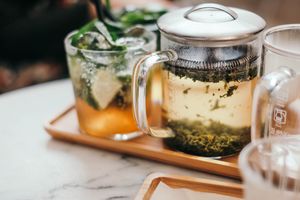
There’s nothing quite like peppermint tea to keep you feeling cozy on a rainy day. Peppermint tea is an herbal tea that packs a serious punch. Its bright and vibrant flavor has a slight cooling effect that you can’t really get with other teas. While we often associate peppermint flavors with cold winter months, the cooling effect makes peppermint tea perfect for any time of year.
A glass of peppermint tea over ice is the perfect summer drink to keep you cool. Likewise, a milky mug of warm peppermint-infused yumminess is an excellent way to feel festive during the holidays.
Peppermint tea is made using, well, peppermint. Like chamomile and hibiscus teas, peppermint tea is an herbal tea. This means it doesn’t contain any true tea—that is, Camellia sinensis. Instead, herbal teas contain other plants and essences. In this case, peppermint takes center stage. A particularly pungent form of mint, peppermint makes for an excellent and aromatic herbal tea.
There are two main types of mint that tea makers usually use for mint tea—spearmint and peppermint. Spearmint has a milder flavor; if you’ve ever had a traditional Moroccan mint tea, you’ve tasted spearmint. It’s especially popular throughout the Mediterranean. On the other hand, peppermint is a bit more sharp.
Compared to spearmint, peppermint has an invigorating flavor profile. Its health benefits make it the perfect guilt-free treat. Read on to learn more about the benefits of peppermint tea, along with our selection of the best peppermint teas out there.
Peppermint tea benefits
Throughout history, peppermint tea has played a significant role in traditional medicine. Like other herbal teas, however, more scientific research into the herb’s role in medicine has yet to be undertaken. Still, its widespread use in traditional medicine suggests that something’s made it stick.
After all, peppermint tea is one of the most widely consumed herbal teas throughout the world—for good reason too. In a review of medicinal uses for peppermint leaves, researchers found that it could have a particularly relaxing effect on the digestive system.
In several animal studies, researchers have found that peppermint tea has a beneficial effect on the digestive system. Specifically, peppermint solutions appear to relax the smooth muscle tissue of the stomach in rabbits and guinea pigs, allowing them to more easily digest and process food. Of course, a rabbit’s stomach is probably quite different from yours, but the results are still promising.
These exact results haven’t been replicated in humans. Still, there are other studies that suggest a beneficial effect on the human digestive process. Peppermint oil solutions appear to reduce nausea in women after surgery. They also reduce the likelihood of muscle spasms in the gastrointestinal tract. By relaxing the muscles in the stomach region, peppermint can reduce cramping as well.
Menthol is the chemical compound that gives peppermint its characteristic cooling aroma and icy hot flavor profile. This compound appears to enhance the respiratory process as well. Inhaling the menthol in peppermint opens up the nostrils, improving their sensitivity to airflow. This can help individuals who are struggling to breathe do so with ease. Individuals with a stuffy nose from allergies or illness may find that peppermint helps them breathe better. This is why menthol-infused treatments like Vicks VapoRub are so successful at clearing up congestion.
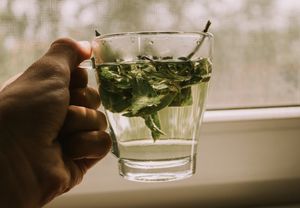
Peppermint tea side effects
For all its benefits, peppermint tea isn’t some magical be-all-end-all herbal remedy. As with all things, moderation is key. While most people can go through several cups of peppermint tea per day, peppermint-curious folks should be careful not to drink too much, as there can be negative side effects.
Earlier, we talked about peppermint tea’s potentially beneficial effects on the gastrointestinal tract. While this is great for most people, individuals who struggle with acid reflux should be careful not to drink too much. Although peppermint can improve digestive function, it can also worsen acid reflux symptoms. Doctors often recommend individuals avoid peppermint if they struggle with chronic acid reflux, as menthol can exacerbate feelings of heartburn and other discomfort associated with acid reflux.
Additionally, individuals who take certain medications should avoid peppermint. Of particular concern is the drug cyclosporine, which organ transplant patients typically take. Peppermint can also lower your blood pressure, so if you’re taking medication for blood pressure issues, peppermint may interfere with things.
All in all, though, peppermint tea is an extremely safe supplement to any diet. For most people, it’s extremely difficult to overdo it. If you’re concerned about potentially experiencing adverse side effects—either because of one of the above side effects, or for other reasons—it’s best to talk to your doctor first before incorporating it into your lineup of teas.
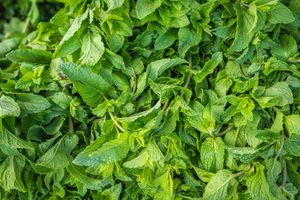
Our pick of the best peppermint teas 2022
There are a lot of different peppermint teas on the market today. Some are better than others. And still, others are much better than the rest. That’s why we’ve rounded up the best peppermint teas you can get in 2022. Whether you prefer your tea straight up or in a blend of different herbs, you’ve come to the right place. We’ve curated the following list of six different peppermint teas that we recommend you try.
If you’re ready to stock up on peppermint teas, look no further than this guide. Here’s our selection of the best peppermint teas out there.
Taylors of Harrogate
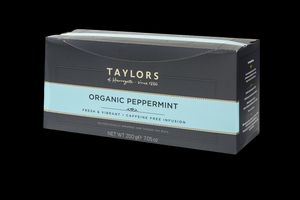
You certainly can’t go wrong with this brand. Taylors of Harrogate’s been in the tea industry since 1886. A family-run business with more than a century’s worth of experience, Taylors knows good tea.
The company’s organic peppermint tea is an exceptionally delightful option. With its intense minty aroma, reviews note that this option has some of the strongest peppermint flavor on the market today. This is an organic peppermint tea that goes best with a dash of sugar or honey. Plus, it comes in convenient (and environmentally sustainable) tea bags, making for a great grab-and-go option for tea lovers in a hurry.
The Tao of Tea
If you prefer a loose leaf tea, The Tao of Tea may be the right option for you. A U.S.-based tea purveyor, The Tao of Tea uses 100% organic peppermint for their peppermint tea.
Loose leaf teas tend to taste a bit fresher than those that come in tea bags. This is because manufacturers typically grind the tea finer for bagged teas, which can give them a stale flavor profile. When it comes to loose leaf peppermint tea, this may be the freshest-tasting one. One customer notes that it tastes almost like peppermint tea brewed using fresh-picked peppermint from the garden.
Xenvi
The digestive benefits of this peppermint blend are particularly enticing. This peppermint tea is infused with orange peel and ginger, both of which build upon the digestive benefits of peppermint. While the peppermint relaxes the stomach, orange peel boosts the metabolism and ginger prevents nausea, making this the holy trinity of digestive health.
Not only does this tea relax the stomach by easing bloating and indigestion, it also tastes exquisite. The mintiness plays well with the spicy, citrus notes of the orange peel and ginger. The citrus notes make it an excellent option for a summery iced tea.
Pukka
Peppermint tea can be a bit one-note at times—that’s why we also recommend this blend of peppermint, spearmint and fieldmint. These three mints compound upon each other, creating a complex and unique minty flavor.
Spearmint is much milder than peppermint, so this is a great option if you find the icy-hot sensation of peppermint a bit overwhelming. Fieldmint has a slightly bitter flavor, but it doesn’t overpower this tea. Because of this slight bitterness, Pukka’s mint tea holds up well to milk and sugar compared to the other teas on this list. Additionally, fieldmint’s digestive benefits may be even stronger than peppermint, making this another excellent option for tea lovers looking for a home remedy for digestive troubles.
Davidson’s
Another excellent option for loose leaf tea lovers, Davidson’s peppermint tea is a high quality option at a great price point. At just $0.89 per ounce, this is a particularly affordable option on the market.
This peppermint tea consists of 100% organic peppermint. Grown on Davidson’s farms in India, this peppermint tea reflects the bright and earthy terroir of Southeast Asia. While it’s also got the vibrant and minty notes you’re likely already familiar with, there’s also a slight earthiness to this tea. And unlike teas that come in tea bags, this intriguing flavor profile remains fresh for quite some time, thanks to the fact that it’s a loose leaf tea.
Teamonk
Last but not least is Teamonk’s peppermint green tea. Unlike the other options on this list, it combines peppermint leaves with green tea leaves. If you love the aromatic notes of peppermint tea but need your fix of caffeine, this is the right peppermint tea for you.
Like peppermint, green tea also has several health benefits. It’s especially good for things like weight loss and improving digestive health. By incorporating the two together, this tea is the perfect digestif. Customers also note that it’s a great option for iced tea lovers. If you need a refreshing summer tea, this may be the best option on our list.
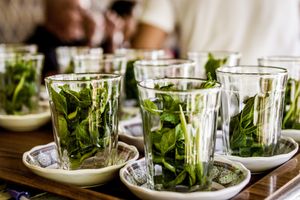
Frequently Asked Questions
Does peppermint tea have caffeine?
No—this makes it the perfect nightcap before bed! Like most herbal teas, pure peppermint tea is completely caffeine-free. While green and black teas have a moderate amount of caffeine, herbal teas typically do not have any caffeine, unless it naturally occurs in the herbs. In the case of peppermint, there’s no caffeine in any part of the plant, so you can rest easy after sipping on a mug of peppermint tea.
Since peppermint tea typically does not contain any _Camellia sinensis _(i.e., true tea), there’s no caffeine in peppermint tea. If true tea is added to the peppermint tea—as in the Teamonks blend listed above—the tea will not be caffeine-free. Before sipping on a late night cup of peppermint tea, be sure to double check the box to make sure it’s 100% peppermint or a blend of peppermint and other herbs.
Do you put milk in peppermint tea?
This one’s up to you. Most people prefer to sip on peppermint tea sans milk, however a splash of milk can add a nice touch. If you’re trying peppermint tea for the first time, we recommend sipping on the above teas without milk to get a better idea of what the pure, unadulterated flavors are like. However, a little bit of milk can add a slight creaminess that pairs quite well with peppermint flavors—think of it like a warmed version of mint chip ice cream.
How long do you steep peppermint tea?
Like most herbal teas, peppermint tea requires a slightly longer steep time than your typical black or green teas. After steeping it in freshly boiled water for 6 minutes, most peppermint teas should be ready for sipping. However, unlike true teas, you can’t really over-steep peppermint tea—some tea producers recommend steeping peppermint tea for 10 to 15 minutes, in order to ensure that you’re getting the strongest, most intense flavor possible.
Is it okay to drink peppermint tea every day?
For the most part, yes! Peppermint tea is a perfectly healthy addition to your tea repertoire. It’s really hard to drink too much. If you happen to have one of the conditions mentioned earlier in this blog (i.e., acid reflux, high blood pressure), you’ll of course want to consult with your doctor before you start guzzling 10 cups a day. However, for most people, it’s perfectly safe to sip on peppermint tea every day.
What’s the difference between peppermint and spearmint tea?
While the two teas taste quite similar, they do have their differences. Peppermint and spearmint are very closely related members of the mint family. Peppermint has a much more intense flavor—this is due to the fact that it has a higher menthol content. Spearmint, on the other hand, is a much sweeter and milder mint. For comparison, peppermint’s composition consists of about 40% menthol, while spearmint only consists of 0.5% menthol. For the most part, their health benefits are similar. However, spearmint’s lower menthol content makes it a better option for individuals who deal with chronic acid reflux.